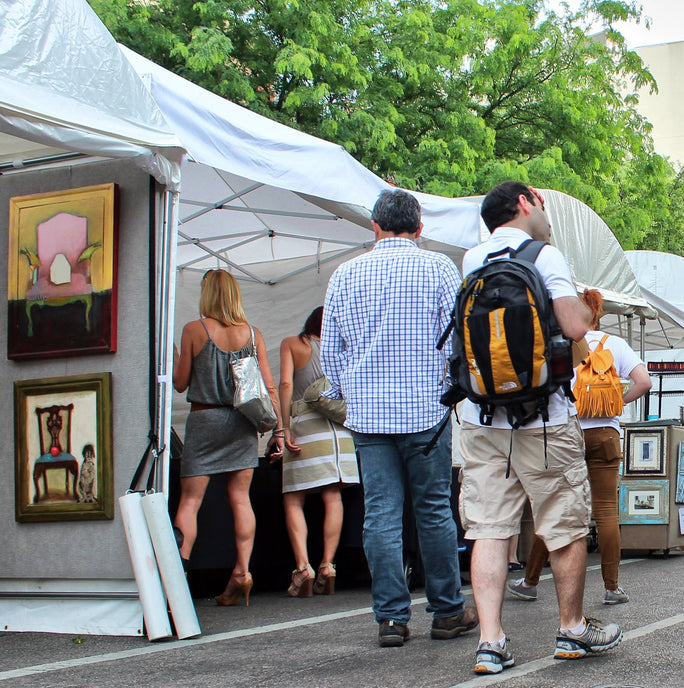We've been sharing tips relating to the best ways to care for your original artwork based on the mediums utilized for their creation. Included on our list is neon, with its unique characteristics which require a specific approach to care. Since neon art and neon signage are essentially one in the same, caring for it involves many of the same simple steps. Before we get into those details, the history of neon, in and of itself, is a fascinating story.
Neon’s Complicated History
Neon lighting was first conceived in 1898 by Scottish chemist Sir William Ramsay through experimentation with neon gasses in a glass tube. When an electric current was applied, the tube was illuminated in glowing hues of crimson. The formula was later perfected by Georges Claude, a Parisian chemist who experimented with additional noble gasses to come up with a wider range of colors. In the beginning, its usage was primarily for advertising and signage purposes, with barber shops and later nightclubs and cinemas being early adopters. While many a shopkeeper in early 1900s Europe was pleased with the beaming intensity of the eye-catching lights for attracting customers, some critics found neon signage gaudy and unrefined.
With its capability for 24/7 illumination, it wasn’t long before major metropolitan areas like New York City embraced the concept of bright lights in the big city that neon offered. Times Square, for example, was soon ablaze in neon lights advertising everything from cigarettes to soft drinks. Cities such as Las Vegas, Nevada soon followed suit, with neon signs offering the perfect way to showcase all the glamour and glitz that Sin City had to offer.
By the 1960s, as new technologies came into play businesses were starting to explore lighting alternatives. Around this same time artists such as Bruce Nauman and Andy Warhol were just beginning to recognize the potential of neon. As opposed to real neon signs, neon art was the conduit for many creatives as a new form of artistic expression. These clever trailblazers saw an opportunity to incorporate the bright lights, vibrant color, and conspicuous text and imagery to express irony, humor, and a bold take on pressing issues of the time.
While it had periodic falls from favor, neon has made numerous comebacks including in recent years in the form of signage, graphic design, home decor, and art. Although its heyday as an art medium was in the 1960s, neon art has gone through ebbs and flows in popularity, including a brief rise in the 80s. Considering a renewed fascination with 80s pop culture, we’ve seen a resurgence of interest in neon art in recent years, with some current-day homeowners incorporating neon light and design as a reflection of their unique style.
Tips for Caring for Neon Art
Consider Placement
Some have pondered whether neon signs and art are safe for their homes. The answer is yes - modern-day neon signs are extremely safe for your domestic spaces. That said, they are charged with a current through a transformer so it is wise to keep your neon art out of reach of kiddos and find a location for which people of any age aren't tempted to touch it. Though it isn’t likely to cause them any harm, when it comes to protecting your art, unnecessary handling is almost always discouraged.
In terms of placement, while we understand a kitchen or garage could be an intriguing place to include neon art to inject a pop of pizazz into spaces that otherwise serve a more perfunctory purpose, proceed with caution. While we aren't saying you absolutely can't display neon art in your kitchen or where you park your automobiles overnight, the idea is to avoid oils and grease. These potential pollutants can easily collect and adhere to your neon art so choose a spot carefully, perhaps opting for an eat-in space as opposed to directly over a stovetop.
Keep It Clean
Although at one time neon signage garnered a reputation as being mostly associated with seedier establishments (hence the name “red light district”), there is no pun intended here. Regularly attending to your neon art to keep it free of dust and grime is an important exercise for maintaining its condition and ensuring it stays bright and vibrant.
Despite the fact that the glass tubing by which neon signs and art are constructed doesn't emit significant heat, it is wise to unplug your pieces before cleaning since they still run off a charge. Some in the neon biz recommend keeping your neon signs and art plugged in most of the time because plugging and unplugging all the time isn't good for the transformer, but this is one of those times when pulling the plug is necessary.
When your’re ready to clean your neon art, you can utilize a vacuum cleaner with a brush attachment to remove superficial dust. Follow this up by gently wiping the tubes of your neon works with a clean cloth. If you fail to give credence to our aforementioned suggestion to keep neon art and signage away from kitchens, you may find your glass tubing has significant build-up, in which case a more thorough cleaning may be required. This can be accomplished by utilizing an ammonia-based cleanser and a little bit of elbow grease applied to the tubing directly.
Bug Off
We recently devoted an entire article to discussing the hazards that insects and other pests pose with regard to art, and this certainly holds true for your neon art. Unfortunately, bugs are attracted to lighting, and neon tubes are particularly seductive in their brightness, so be vigilant to keep these vermin at bay.
Unless you're running a commercial operation out of your home, the odds are that your neon art is confined to indoor spaces, making this task more manageable. In this case, the various steps we outlined previously relating to pest control and basic cleaning strategies should suffice.
We hope these tips have been helpful in identifying the best ways to care for your neon art. If you’re in the market for original art, you can shop our curated online gallery which is updated weekly with the latest offerings by talented artists.







